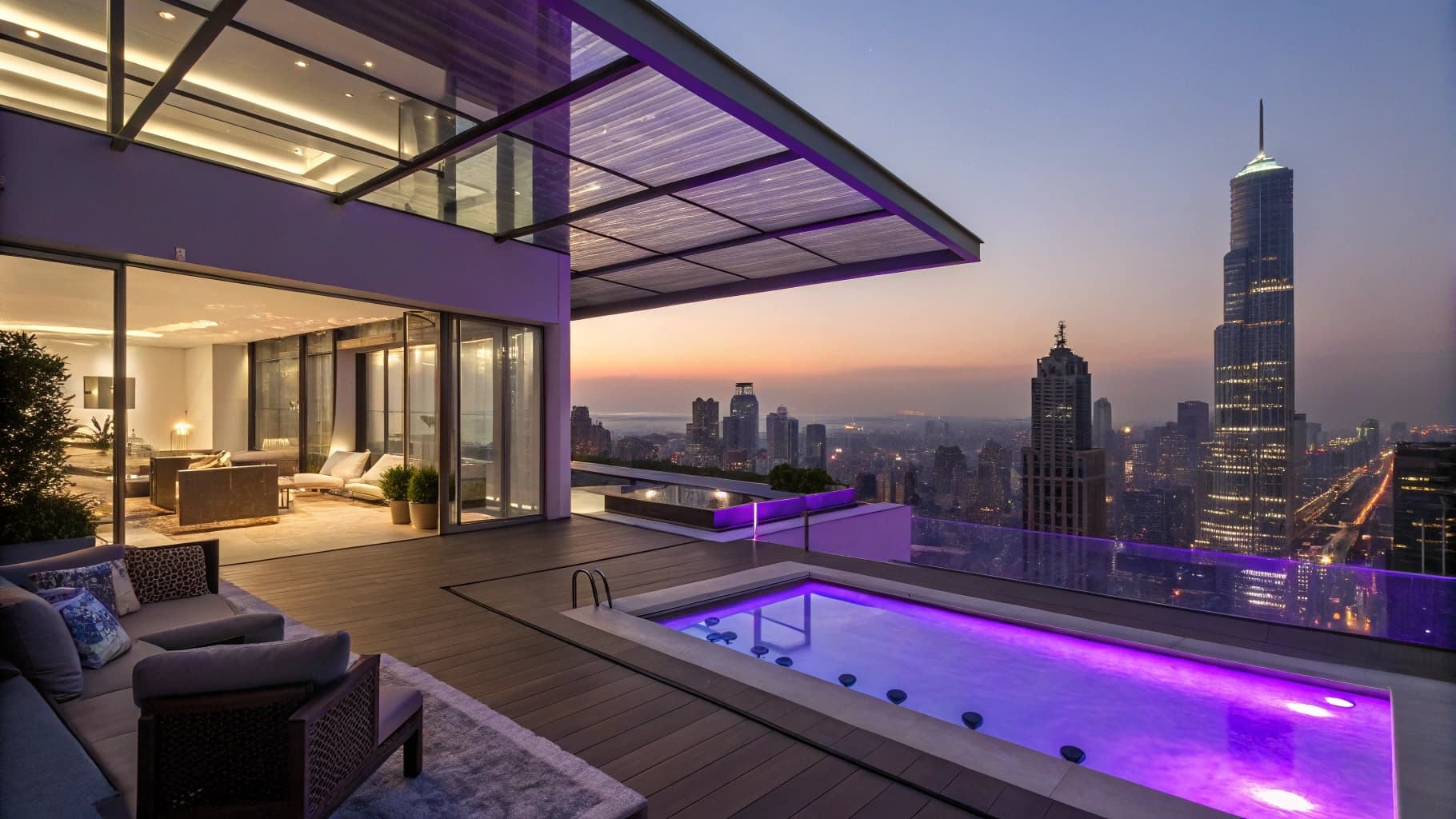As I delve into the history of penthouses, I find myself captivated by their evolution from simple rooftop structures to symbols of luxury and exclusivity. The term “penthouse” originally referred to a small structure built on the roof of a building, often used for storage or as a simple living space. Over time, these spaces transformed into lavish residences that epitomize urban sophistication.
The allure of penthouse living has always been tied to its elevated position, offering breathtaking views and a sense of privacy that is hard to find in traditional apartments. The journey of the penthouse reflects broader societal changes, including shifts in architecture, urbanization, and lifestyle preferences. In the early 20th century, as cities expanded and skyscrapers began to dominate the skyline, penthouses emerged as desirable living spaces for the affluent.
They became a status symbol, representing not just wealth but also a certain lifestyle that many aspired to achieve. As I explore this fascinating history, I am reminded of how architecture can mirror cultural values and aspirations, making the penthouse a compelling subject of study.
Early Penthouse Designs: From Rooftop Shacks to Urban Retreats
From Practicality to Luxury
As urbanization progressed, so did the design and function of penthouses. Architects began to recognize the potential of these elevated spaces, transforming them into urban retreats that offered both comfort and style. I find it fascinating how these early designs laid the groundwork for what would become a thriving market for luxury penthouses.
Natural Light and Breathtaking Views
The introduction of larger windows and open floor plans allowed for more natural light and better views, making these spaces increasingly appealing to city dwellers seeking a slice of tranquility amidst the chaos.
A New Era of Urban Living
Today, penthouses represent the epitome of luxury urban living, offering residents a unique blend of comfort, style, and tranquility in the heart of the city.
The Rise of Luxury: Penthouses in the 20th Century
The 20th century marked a significant turning point in the history of penthouses, as they evolved into symbols of luxury and exclusivity. With the rise of skyscrapers in major cities like New York and Chicago, penthouses became highly sought-after residences for the wealthy elite. I often think about how this shift reflected broader societal changes, including increased disposable income and a growing emphasis on personal comfort and status.
The penthouse became more than just a home; it was a statement about one’s success and lifestyle. During this period, architects began to push the boundaries of design, creating stunning penthouses that featured expansive terraces, private pools, and state-of-the-art amenities. I am particularly drawn to the stories of famous penthouse owners—celebrities, business moguls, and artists—who transformed these spaces into personal sanctuaries.
The allure of penthouse living was not just about the physical space; it was also about the lifestyle it represented. As I reflect on this era, I can see how penthouses became synonymous with glamour and sophistication, forever changing the landscape of urban living.
Modern Amenities: The Evolution of Penthouse Features
As I explore modern penthouses today, I am struck by the incredible array of amenities that have become standard features in these luxurious spaces. Gone are the days when a simple rooftop terrace sufficed; contemporary penthouses now boast high-end finishes, smart home technology, and expansive outdoor living areas. I find it fascinating how these advancements have redefined what it means to live in a penthouse.
From private gyms to home theaters, these residences cater to every conceivable need and desire. The integration of technology into penthouse design is particularly noteworthy. Smart home systems allow residents to control lighting, temperature, and security with just a few taps on their smartphones.
I appreciate how this level of convenience enhances the overall living experience, making it easier for residents to enjoy their luxurious surroundings. Additionally, many modern penthouses feature eco-friendly designs that prioritize sustainability without sacrificing style. This evolution reflects a growing awareness of environmental issues and a desire for responsible living in urban settings.
The Global Impact: Penthouse Living Around the World
Penthouse living is not confined to one city or culture; it has become a global phenomenon that transcends borders. As I examine penthouses around the world, I am amazed by the diverse architectural styles and cultural influences that shape these unique spaces. In cities like Hong Kong and Dubai, penthouses often feature sleek, modern designs that reflect their fast-paced environments.
In contrast, European cities like Paris and Rome offer penthouses that blend historical charm with contemporary luxury. I find it intriguing how penthouses can serve as cultural touchstones within their respective cities. They often reflect local architectural trends while also catering to international tastes.
For instance, a penthouse in New York City may prioritize open spaces and panoramic views, while one in Tokyo might incorporate traditional elements like sliding doors and tatami mats. This global impact highlights not only the versatility of penthouse design but also its ability to adapt to different lifestyles and preferences.
Sustainable Design: Green Initiatives in Modern Penthouse Construction
The Evolution of Luxury Living
Penthouses are no longer just about opulence; they are also becoming models of sustainability. Incorporating green roofs, solar panels, and rainwater harvesting systems are just a few examples of how modern penthouses are embracing sustainability. These features not only reduce environmental impact but also enhance the quality of life for residents.
Harmony with Nature
I appreciate how many developers are now focusing on creating spaces that harmonize with nature rather than simply dominating it. This commitment to sustainability reflects a broader societal shift towards responsible living and environmental stewardship.
A New Era of Sustainability
This shift towards sustainable design practices is not only beneficial for the environment, but it also sets a new standard for luxury living. As we move forward, I am excited to see how sustainable design will continue to shape the future of penthouse living.
The Future of Penthouse Living: Trends and Innovations
Looking ahead, I am excited about the trends and innovations shaping the future of penthouse living. As urban populations continue to grow, there is an increasing demand for innovative housing solutions that maximize space while providing comfort and luxury. I believe that we will see more creative uses of vertical space in penthouse design, with multi-level layouts that offer unique living experiences.
Additionally, advancements in technology will continue to play a significant role in shaping modern penthouses. From virtual reality tours to advanced home automation systems, I envision a future where technology seamlessly integrates with design to enhance everyday living. Furthermore, as cities become more congested, I anticipate a rise in communal amenities within penthouse buildings—shared gardens, fitness centers, and social spaces that foster community among residents while still providing the privacy associated with penthouse living.
The Enduring Allure of the Modern Penthouse
In conclusion, my exploration of penthouses has revealed their enduring allure as symbols of luxury, comfort, and innovation. From their humble beginnings as rooftop shacks to their current status as coveted residences around the world, penthouses have continually evolved to meet the changing needs and desires of urban dwellers. As I reflect on this journey through history, design, and culture, I am reminded that penthouses represent more than just physical spaces; they embody aspirations for a lifestyle marked by elegance and sophistication.
The future of penthouse living is bright, with exciting trends in sustainability and technology paving the way for even more innovative designs. As cities continue to grow and change, I believe that penthouses will remain at the forefront of urban living—offering not only breathtaking views but also a unique blend of luxury and responsibility. Ultimately, it is this combination that ensures the enduring appeal of the modern penthouse for generations to come.
FAQs
What is a penthouse?
A penthouse is a luxurious apartment or residence that is typically located on the top floor of a high-rise building, offering panoramic views and often featuring high-end amenities and design.
How has the modern penthouse evolved over time?
The modern penthouse has evolved from its origins as a simple rooftop shack to a symbol of luxury and exclusivity. In the early 20th century, penthouses were often used as servants’ quarters, but they have since become highly sought-after properties for the wealthy and elite.
What are some common features of modern penthouses?
Modern penthouses often feature spacious layouts, high ceilings, floor-to-ceiling windows, private terraces or rooftop gardens, and top-of-the-line amenities such as gourmet kitchens, spa-like bathrooms, and smart home technology.
How are modern penthouses designed to maximize luxury and comfort?
Modern penthouses are designed to maximize luxury and comfort through the use of high-end materials, custom finishes, and thoughtful layouts that prioritize open living spaces and seamless indoor-outdoor flow. Additionally, many modern penthouses offer exclusive access to amenities such as private elevators, concierge services, and on-site fitness centers.
What are some notable examples of modern penthouses around the world?
Notable examples of modern penthouses around the world include the One Hyde Park penthouse in London, the Atelier 505 penthouse in Boston, and the Faena Penthouse in Miami Beach. These properties are known for their stunning architecture, breathtaking views, and unparalleled luxury.

